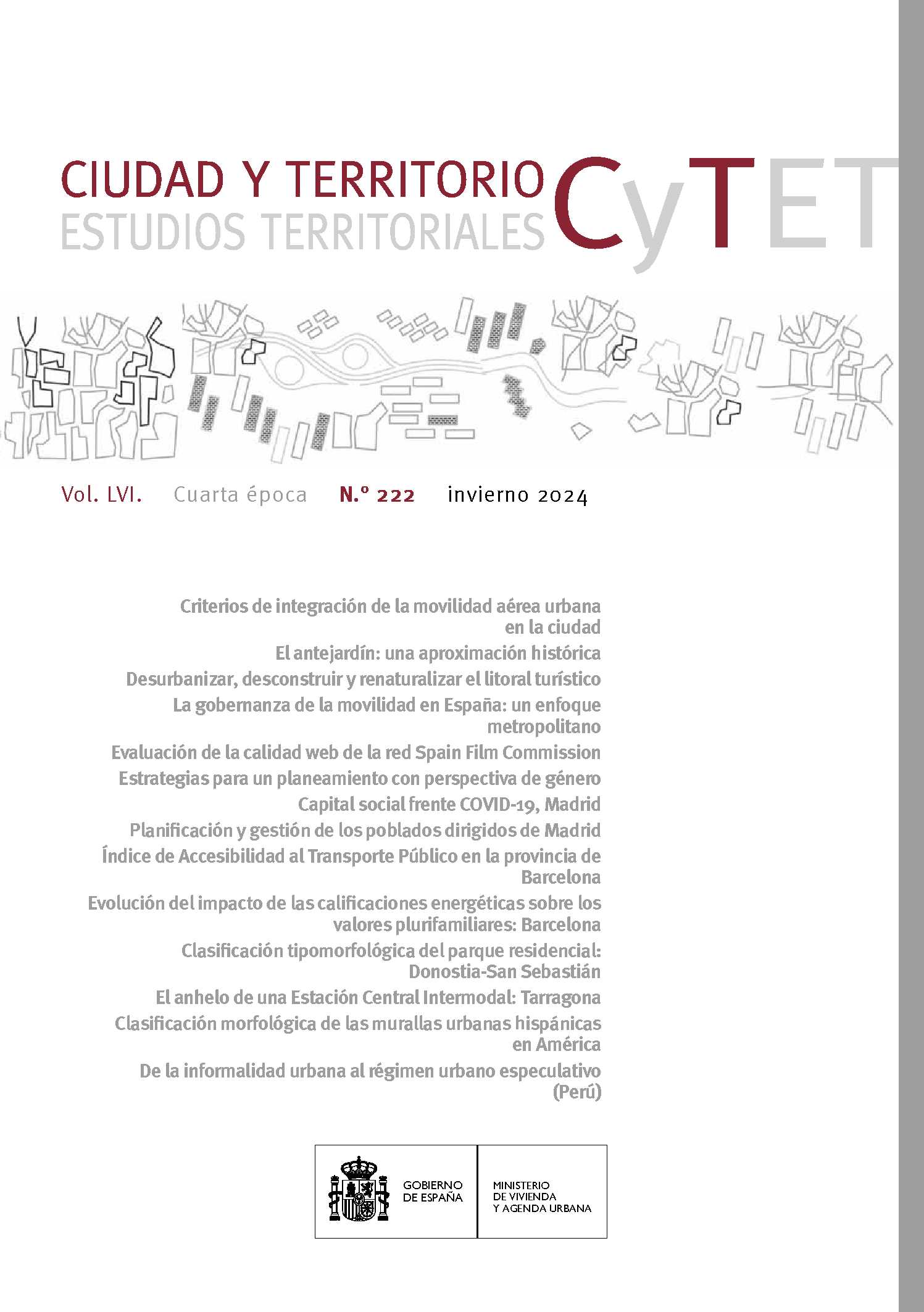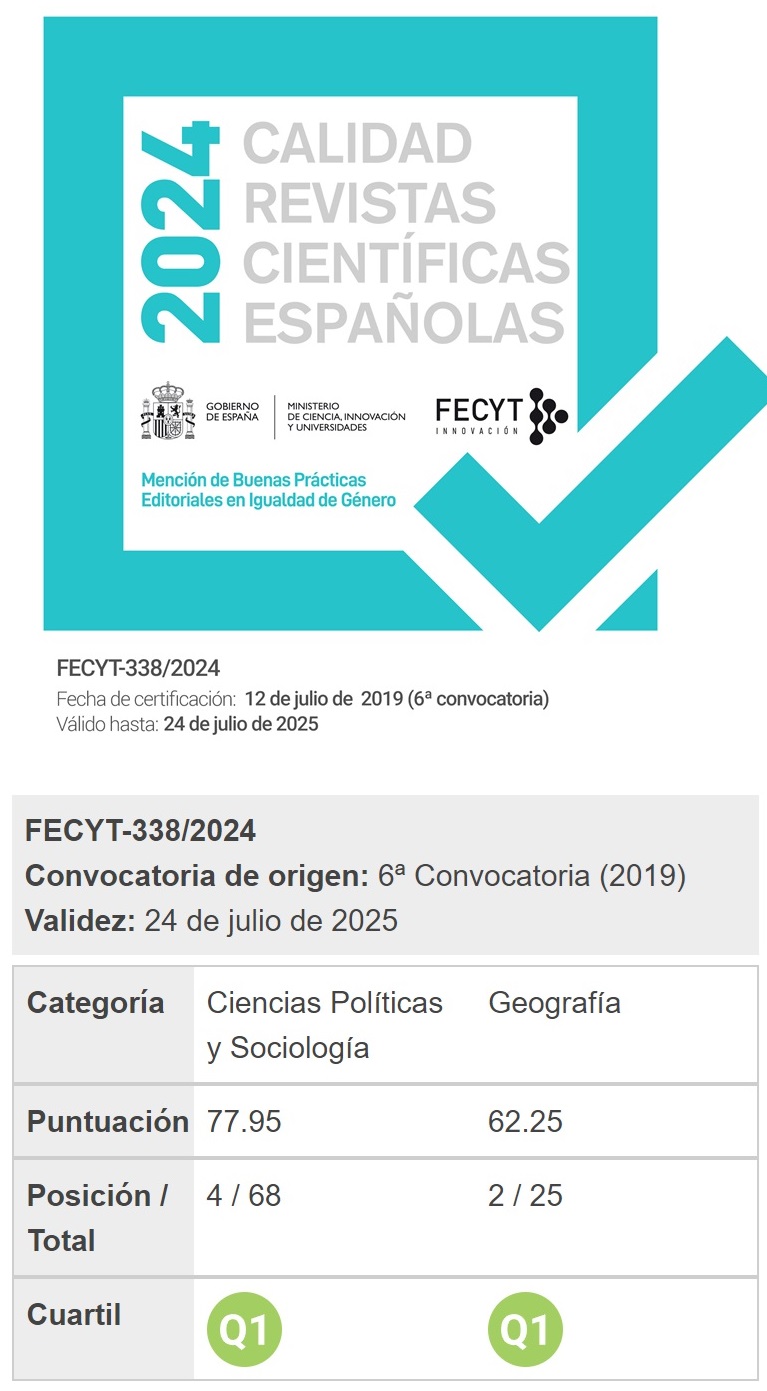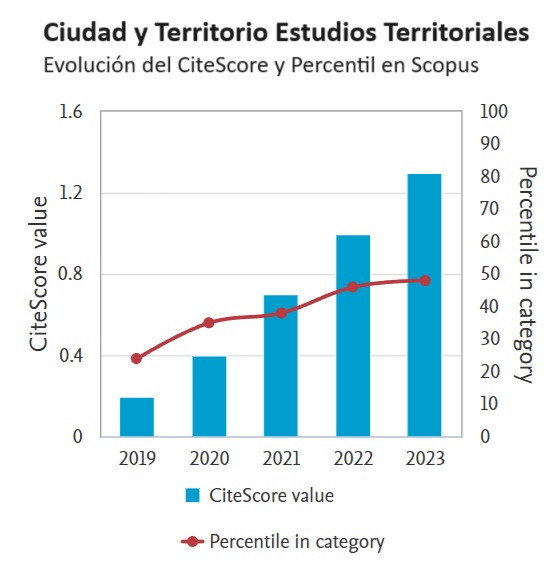Método para la clasificación tipomorfológica del parque residencial: caso estudio Donostia-San Sebastián
DOI:
https://doi.org/10.37230/CyTET.2024.222.11Palabras clave:
Análisis tipomorfológico, Spacemate, Tipología edificatoria, Forma Urbana, Sistemas de Información GeográficaResumen
Este artículo presenta una nueva metodología para una clasificación precisa y sistemática del parque edificado a escala municipal. Los métodos desarrollados hasta ahora consideraban variables edificatorias y obtenían resultados genéricos que no son suficientemente detallados para obtener una segmentación que recoge la diversidad del parque residencial de los municipios españoles. La principal aportación de este trabajo es la combinación de dos variables urbanas (densidad-forma urbana y tipología arquitectónica) con las dos variables propias de la edificación que se vienen utilizando más habitualmente (año de construcción y número de plantas). Ello permite desarrollar una clasificación más precisa que hace posible la identificación de cada edificio dentro de su contexto histórico y urbanístico y posibilita una caracterización del parque más detallada. Para su aplicación, se ha creado una herramienta de Sistemas de Información Geográfica (SIG) y se han utilizado software y fuentes de datos de libre acceso. Se ha implementado en el caso de estudio de Donostia-San Sebastián pero es exportable a otros contextos. Los resultados muestran que la metodología propuesta proporciona una clasificación singular y detallada de las tipomorfologías del parque residencial existentes en la ciudad y posibilita un conocimiento profundo de la realidad útil para la toma de decisiones y definición de estrategias y políticas urbanas.
Descargas
Citas
ARCAS-ABELLA, J. & PAGÈS-RAMON, A. & LARRUMBIDE, E. & HUERTA, D. (2019): Segmentación del parque residencial de viviendas en España en clústeres tipológicos. Dirección General de Arquitectura, Vivienda y Suelo. Ministerio de Fomento.
BALLARINI, I. & CORGNATI, S. P. & CORRADO, V. (2014): Use of reference buildings to assess the energy saving potentials of the residential building stock: The experience of TABULA project. Energy Policy, 68, pp. 273-284. https://doi.org/10.1016/j.enpol.2014.01.027
BERGHAUSER PONT, M. Y. (2009): Space, Density and Urban Form. In Institutional Repository. Institutional Repository.
BERGHAUSER PONT, M. Y. & HAUPT, P. A. (2007): The relation between urban form and density. Urban Morphology, 11(1), 62–67.
BOYKO, C. T.& COOPER, R. (2011): Clarifying and re-conceptualising density. Progress in Planning, 76(1), pp. 1-61. https://doi.org/10.1016/J.PROGRESS.2011.07.001
BURTON, E. (2002): Measuring urban compactness in UK towns and cities. Environment and Planning B: Planning and Design, 29, pp. 219-250.
CAPUTO, P. & COSTA, G. & FERRARI, S. (2013): A supporting method for defining energy strategies in the building sector at urban scale. Energy Policy, 55, pp. 261-270. https://doi.org/10.1016/J.ENPOL.2012.12.006
CHURCHMAN, A. (1999): Disentangling the concept of density. Journal of Planning Literature, 13(4), pp. 389-411. https://doi.org/10.1177/08854129922092478
DASCALAKI, E. G. & DROUTSA, K. & GAGLIA, A. G. & KONTOYIANNIDIS, S. & BALARAS, C. A. (2010): Data collection and analysis of the building stock and its energy performance—An example for Hellenic buildings. Energy and Buildings, 42(8), pp. 1231-1237. https://doi.org/10.1016/J.ENBUILD.2010.02.014
DEPARTAMENTO DE PLANIFICACIÓN TERRITORIAL, V. Y T. (2019): Long-term intervention strategy for the Basque Country's building stock. Planificación territorial y urbanismo - Euskadi.eus. Regeneración Urbana .
DOVEY, K. & PAFKA, E. (2014): The urban density assemblage: Modelling multiple measures. Urban Design International, 19(1), pp. 66-76. https://doi.org/10.1057/UDI.2013.13
DU, S. & LUO, L. & CAO, K. & SHU, M. (2016): Extracting building patterns with multilevel graph partition and building grouping. ISPRS Journal of Photogrammetry and Remote Sensing, 122, pp. 81-96. https://doi.org/10.1016/J.ISPRSJPRS.2016.10.001
ERNEST R. A. (1993): Density measures: A review and analysis. Journal of Architectural and Planning Research, 10(3), pp. 181-202.
ESTEBAN GARBAYO, J. DE (2017): Principles of the urban form in the work of Leslie Martin and the LUBFS. ZARCH, 8, pp. 170-183. https://doi.org/10.26754/OJS_ZARCH/ZARCH.201782154
EUROPEAN COMMISION (2021): A Renovation wave for Europe. EU Buildings Projects.
EUROPEAN COMMISION & EUROPEAN PARLAMENT (2018): Revision of the Energy Performance of Buildings Directive. Official Journal of the European Union.
EUSTAT (Instituto vasco de Estadística) (2020a): Tablas estadísticas: Edificios de la C.A. de Euskadi por ámbitos territoriales, según tipo de edificio.
EUSTAT (Instituto vasco de Estadística) (2020b): Viviendas familiares de la C.A. de Euskadi por ámbitos territoriales y número de viviendas del edificio.
GARCÍA-MARTÍN, M.F. (2020): La forma urbana : un estudio de las periferias de las ciudades intermedias españolas a lo largo del siglo XX.
HASSLER, U. (2010): Long-term building stock survival and intergenerational management: the role of institutional regimes. The Historic Environment: Policy & Practice , 37(5-6), pp. 552-568. https://doi.org/10.1080/09613210903189533
Instituto Nacional de Estadística INE (2021): Gipuzkoa: Población por municipios y sexo.
KREHL, A. & SIEDENTOP, S. & TAUBENBÖCK, H. & WURM, M. (2016): A comprehensive view on urban spatial structure: Urban density patterns of German city regions. ISPRS International Journal of Geo-Information, 5(6). https://doi.org/10.3390/IJGI5060076
LI, X. & YAO, R. & LIU, M. & COSTANZO, V. & YU, W. & WANG, W. & SHORT, A. & LI, B. (2018): Developing urban residential reference buildings using clustering analysis of satellite images. Energy and Buildings, 169, pp. 417-429. https://doi.org/10.1016/J.ENBUILD.2018.03.064
LIDDELL, C. & MORRIS, C. (2010): Fuel poverty and human health: A review of recent evidence. Energy Policy, 38(6), 2987–2997. https://doi.org/10.1016/J.ENPOL.2010.01.037
LOGA, T. & STEIN, B. & DIEFENBACH, N. (2016): TABULA building typologies in 20 European countries—Making energy-related features of residential building stocks comparable. Energy and Buildings, 132, pp. 4-12. https://doi.org/10.1016/J.ENBUILD.2016.06.094
LOWRY, J. H. & LOWRY, M. B. (2014): Comparing spatial metrics that quantify urban form. Computers, Environment and Urban Systems, 44, pp. 59-67. https://doi.org/10.1016/J.COMPENVURBSYS.2013.11.005
MATA, É. & SASIC KALAGASIDIS, A. & JOHNSSON, F. (2013): Energy usage and technical potential for energy saving measures in the Swedish residential building stock. Energy Policy, 55, pp. 404-414. https://doi.org/10.1016/J.ENPOL.2012.12.023
MEINEL, G. & HECHT, R. & HEROLD, H. (2009): Analyzing building stock using topographic maps and GIS. Building Research and Information, 37(5-6), pp. 468-482. https://doi.org/10.1080/09613210903159833
NEIDHART, H. & SESTER, M. (2004): Identifying building types and building clusters using 3D-laser scanning and GIS-data. Geo-Imagery Bridging Continents.
Organización para la Cooperación y el Desarrollo Económicos, OECD. (2012): Compact City Policies: A Comparative Assessment. OECD Green Growth Studies.
PODCZECK, F. (1997): A shape factor to assess the shape of particles using image analysis. Powder Technology, 93(1), pp. 47-53. https://doi.org/10.1016/S0032-5910(97)03257-9
RAPOPORT, A. (1975): Toward a Redefinition of Density. Environment and Behavior, 7(2), 133-158. https://doi.org/10.1177/001391657500700202
SAMBRICIO, C. (2003): De la manzana cerrada al bloque abierto. Un siglo de vivienda social 1903-2003 : centenario del Instituto de Reformas Sociales. Ed. Nerea.
SANTIAGO-RODRÍGUEZ DE, E. (2021): Vista de La Estrategia de Rehabilitación ERESEE 2020: una oportunidad para un cambio de modelo en el sector de la vivienda en España. Ciudad y Territorio, Estudios Territoriales, LIII, 239–276.
SCHICK, A. & FISCHER, M. & STIEFELHAGEN, R. (2012): Measuring and evaluating the compactness of superpixels. Computer Science, Mathematics.
SCHWARZ, N. (2010): Urban form revisited-Selecting indicators for characterising European cities. Landscape and Urban Planning, 96(1), pp. 29-47. https://doi.org/10.1016/J.LANDURBPLAN.2010.01.007
SOLÁ-MORALES DE, M. (1973): Las formas de crecimiento urbano. Escola Tècnica Superior d’Arquitectura de Barcelona.
STEINIGER, S. & LANGE, T. & BURGHARDT, D. & WEIBEL, R. (2008): An Approach for the Classification of Urban Building Structures Based on Discriminant Analysis Techniques. Transactions in GIS, 12(1), pp. 31-59. https://doi.org/10.1111/J.1467-9671.2008.01085.X
STUTZ, D. & HERMANS, A. & LEIBE, B. (2018): Superpixels: An evaluation of the state-of-the-art. Computer Vision and Image Understanding, 166, pp. 1-27. https://doi.org/10.1016/J.CVIU.2017.03.007
THEODORIDOU, I. & PAPADOPOULOS, A. M. & HEGGER, M. (2011a): Statistical analysis of the Greek residential building stock. Energy and Buildings, 43, pp. 2422-2428. https://doi.org/10.1016/j.enbuild.2011.05.034
THEODORIDOU, I. & PAPADOPOULOS, A. M. & HEGGER, M. (2011b): A typological classification of the Greek residential building stock. Energy and Buildings, 43(10), pp. 2779-2787. https://doi.org/10.1016/J.ENBUILD.2011.06.036
THEODORIDOU, I. & PAPADOPOULOS, A. M. & HEGGER, M. (2012): A feasibility evaluation tool for sustainable cities – A case study for Greece. Energy Policy, 44, pp. 207-216. https://doi.org/10.1016/J.ENPOL.2012.01.042
TOMMERUP, H. & SVENDSEN, S. (2006): Energy savings in Danish residential building stock. Energy and Buildings, 38(38), pp. 618-626. https://doi.org/10.1016/J.ENBUILD.2005.08.017
UIHLEIN, A. & EDER, P. (2010): Policy options towards an energy efficient residential building stock in the EU-27. Energy and Buildings, 42(6), pp. 791-798. https://doi.org/10.1016/J.ENBUILD.2009.11.016
UN-HABITAT. (2015): Issue paper on urban and spatial planning and design. The Habitat III Issue Papers.
WURM, M. & SCHMITT, A. & TAUBENBÖCK, H. (2016): Building Types’ Classification Using Shape-Based Features and Linear Discriminant Functions. IEEE Journal of Selected Topics in Applied Earth Observations and Remote Sensing, 9(5), pp. 1901-1912. https://doi.org/10.1109/JSTARS.2015.2465131
Publicado
Cómo citar
Número
Sección
Licencia
Derechos de autor 2024 Mikel Barrena-Herrán, Itziar Modrego-Monforte, Olatz Grijalba, Irati Otamendi-Irizar

Esta obra está bajo una licencia internacional Creative Commons Atribución-NoComercial-SinDerivadas 4.0.
Sin perjuicio de lo dispuesto en la legislación vigente sobre Propiedad Intelectual, y conforme a la misma, el/la los/las autor/a/es/as que publiquen en CyTET cede/n a título gratuito, de modo no exclusivo y sin límite temporal al Ministerio de Transportes, Movilidad y Agenda Urbana los derechos para difundir, reproducir, comunicar y distribuir en cualquier formato actual o futuro, en papel o electrónico, la versión original o derivada de su obra bajo licencia de Creative Commons Reconocimiento-NoComercial-SinObraDerivada 4.0 Internacional (CC BY-NC-ND 4.0), así como para incluir o ceder a terceros la inclusión de su contenido en índices, repositorios y bases de datos nacionales e internacionales, con referencia y reconocimiento en todo caso de la autoría del mismo.
Además, al realizar el envío, el/la los/las autor/a/es/as declara/n que se trata de un trabajo original en el que se reconocen las fuentes que han sido utilizadas en su estudio, comprometiéndose a respetar la evidencia científica y a no modificar los datos originales para verificar o refutar una hipótesis de partida; que el contenido esencial del mismo no ha sido publicado previamente ni se publicará en ninguna otra obra o revista mientras esté en proceso de evaluación en la revista CyTET; y que no se ha remitido simultáneamente a otra publicación.
Los autores deben firmar un Formulario de Cesión de Derechos, que les será enviado desde la Secretaría de CyTET una vez se acepte su artículo para ser publicado.
Con el objetivo de favorecer la difusión del conocimiento, CyTET se adhiere al movimiento de revistas de Open Access (OA) y entrega la totalidad de sus contenidos a diversos índices, repositorios y bases de datos nacionales e internacionales bajo este protocolo; por tanto, la remisión de un trabajo para ser publicado en la revista presupone la aceptación explícita por parte del autor/a de este método de distribución.
Se anima a las/os autoras/es a reproducir y alojar sus trabajos publicados en CyTET en repositorios institucionales, páginas web, etc. con la intención de contribuir a la mejora de la transferencia del conocimiento y de la citación de dichos trabajos.








 Enlace a CyTET en Linkedin
Enlace a CyTET en Linkedin